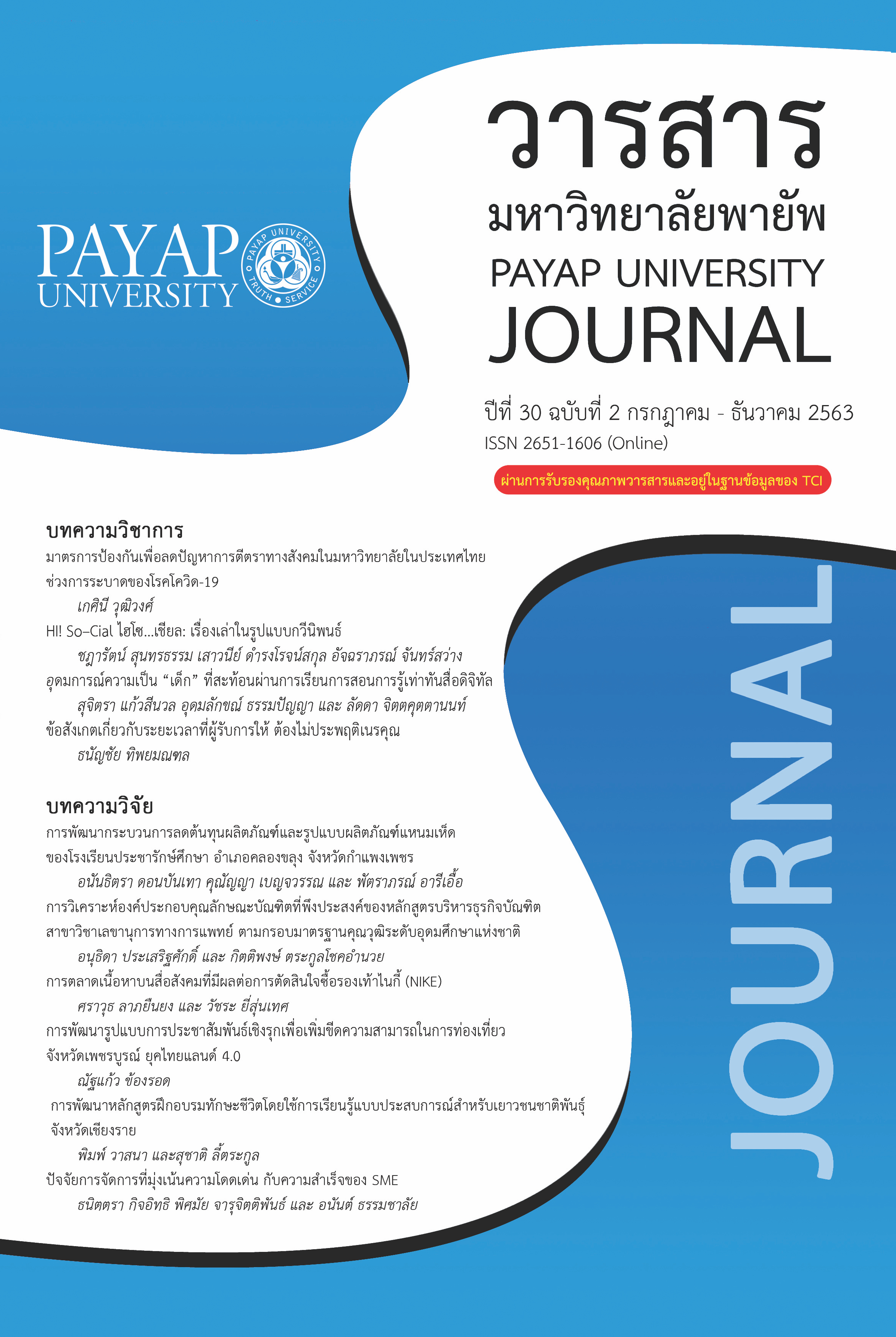Preventative Measures to Reduce Social Stigma in Universities in Thailand During the COVID-19 Pandemic
Main Article Content
Abstract
The social stigma associated with foreign students or any suspected group during the COVID-19 pandemic is related to fear of exposure to the disease, lack of knowledge of the disease, and a general negative attitude toward the suspected group. The effects of social stigma are fear of each other, isolation from each other, non-attendance of classes, and the tendency to deny assistance to each other. The objective of this article is to suggest two main measures to prevent and reduce social stigma in universities in Thailand as follows: 1.) The 4S structural measure including Shape our teams, Survey of opinions, Speak out, and Surrounding support and 2.) The 1S and 2P individual measures including “Sang” - raise people,s awareness; “Prap” - mindset changing and “Pluk” - recall our sense of dignity as human beings. Implementing these measures can help our universities’ students and staff have a positive response to the COVID-19 pandemic by raising their awareness to treat others appropriately in order to prevent and reduce the problems of social stigma.
Article Details
References
กรมควบคุมโรค. (2563ค). มารู้จักไวรัสสายพันธุ์ใหม่ 2019, สืบค้นเมื่อ 1 เมษายน 2563. http://ddc.moph.go.th/viralpneumonia/img/infographic/info14.jpg.
กรมควบคุมโรค. (2563ก). รายงานสถานการณ์โควิด 19, สืบค้นเมื่อ 10 กรกฎาคม 2563. https://covid19.ddc.moph.go.th/.
กรมควบคุมโรค. (2563ข). COVID – 19 (EOC -DDC Thailand) โรคติดเชื้อไวรัสโคโรนา 2019, สืบค้นเมื่อ 10 กรกฎาคม 2563. https://ddcportal.ddc.moph.go.th/portal/apps/opsdashboard /index.html#/20f3466e075e45e5946aa87c96e8ad65.
กรมสุขภาพจิต. (2563). คู่มือปฏิบัติงานทีมช่วยเหลือเยียวยาจิตใจทุกระดับ: ผู้ประสบภัยภาวะวิกฤตในกรณีการระบาดของโรคติดเชื้อไวรัสโคโรนา 2019 (COVID-19). สืบค้น 10 ตุลาคม 2563. https://www.dmh.go.th/covid19/pnews/files/MCATTupdate.pdf.
กรมอนามัย กระทรวงสาธารณสุข. (2563). คู่มือการปฏิบัติสำหรับสถานศึกษาในการป้องกันการแพร่ระบาดของโรคโควิด 19, สืบค้นเมื่อ 11 กรกฎาคม 2563. https://multimedia.anamai.moph.go.th /wp-content/uploads/2020/06/Educational-Manual-Covid19-final-Complete2.pdf.
โคโรนา: อนามัยโลกตั้งชื่อ โควิด 19 ให้โรคทางเดินหายใจจากไวรัสสายพันธ์ใหม่. (2563, 12 กุมภาพันธ์). บีบีซี. สืบค้นเมื่อ 1 เมษายน 2563. https://www.bbc.com/thai/features-51473472.
จำรอง เงินดี. (2552). จิตวิทยาสังคม. กรุงเทพฯ: โอ เอ พริ้นติ้ง เฮ้าส์.
ต่างชาติเรียนเชียงใหม่พุ่ง เด็กไทยแห่เรียนจีนเพิ่มหวังสร้างโอกาส.(2562, 22 เมษายน). เชียงใหม่นิวส์. สืบค้นเมื่อ 1 มีนาคม 2563, https://www.chiangmainews.co.th /page/archives
/980130/.
เปิดข้อมูลผู้ติดเชื้อ COVID-19 ในไทย เคส 1 – 47. (2563, 6 มีนาคม). ไทยพีบีเอส. สืบค้นเมื่อ 1 เมษายน 2563. https://news.thaipbs.or.th/content/289592.
ธนรักษ์ ผลิพัฒน์. (2563, 31 มีนาคม). แพทย์ชี้ “3 ฉากทัศน์ โควิด 19”. มติชนออนไลน์. สืบค้นเมื่อ 31 มีนาคม 2563, https://www.matichon.co.th/covid19/thai-covid19/news_2109407.
นิด้าโพลทำสำรวจโควิด 19. (2563, 15 มีนาคม). มติชนออนไลน์. สืบค้นเมื่อ 1 เมษายน 2563, https://www.matichon.co.th/local/quality-life/news_2057073.
ปราณ สุวรรณทา. (2563, 05 มีนาคม). กลัวได้แต่อย่าวิตก เรียนรู้วิธีรับมือโควิด 19 ของสิงคโปร์ที่ WHO ออกปากชม, สืบค้นเมื่อ 15 มีนาคม 2563. https://brandinside.asia/how-to-get-rid-of-fear-during-covid-19/.
เผยผลสำรวจความรอบรู้ด้านสุขภาพเพื่อป้องกัน ‘โควิด-19’ ยังเข้าใจผิดเรื่องงดออกจากบ้าน. (2563, 02 กุมภาพันธ์). Hfocus. สืบค้นเมื่อ 11 กรกฏาคม 2563, https://www.hfocus.org /content/2020/04/18851.
พูนสุข เวชวิฐาน. (บ.ก.). (2559). เอกสารการสอนชุดวิชาจิตวิทยาเพื่อการดำรงชีวิต หน่วยที่ 1-7. นนทบุรี: มหาวิทยาลัยสุโขทัยธรรมาธิราช.
พูนสุข เวชวิฐาน. (บ.ก.). (2559). เอกสารการสอนชุดวิชาจิตวิทยาเพื่อการดำรงชีวิต หน่วยที่ 8-15. นนทบุรี: มหาวิทยาลัยสุโขทัยธรรมาธิราช.
ภานุเมศ ตันรักษา. (2563, 2 กุมภาพันธ์). อย่าให้ไวรัสโคโรนามาสร้างความเกลียดชังให้พี่น้องไทยจีน. โพสต์ทูเดย์. สืบค้นเมื่อ 10 กรกฎาคม 2563, จาก https://www.posttoday.com /social/general/613618.
ภูริภัทร สังขพัฒน์. (2563, 06 กุมภาพันธ์). “ชาวเอเชีย” แพะรับบาปไวรัสโคโรนา กระแสเกลียดกลัวชาวต่างชาติที่แพร่ระบาดไปทั่วโลก. The Standard. สืบค้นเมื่อ 2 เมษายน 2563, https://thestandard.co/coronavirus-outbreak/.
ยูนิเชฟ. (2563, 31 มีนาคม). วิธีสื่อสารกับเด็กนักเรียนเกี่ยวกับโรคไวรัสโคโรน่า (โควิด-19), สืบค้นเมื่อ 4 เมษายน 2563. https://www.unicef.org/thailand/th/coronavirus/how-teachers-can-talk-children-about-coronavirus-disease-covid-19.
ราชวิทยาลัยจิตแพทย์แห่งประเทศไทย. (2563). ประกาศราชวิทยาลัยจิตแพทย์แห่งประเทศไทยที่ 8/2563 เรื่องคำแนะนำในการดูแลจิตใจช่วงการระบาดของไวรัส โควิด 19, สืบค้นเมื่อ 11 กรกฎาคม 2563. https://drive.google.com/file/d/1PEvxrXhu8s8QRwOUDut 1H0qxehe2Da1H/view?fbclid=IwAR3wYuwh3E3bdrQBMK9K1v78M7FsOtXOKG8yhCeVBU0hwDO09aM52FGMnjU.
สถาบันวิจัยสังคม จุฬาลงกรณ์มหาวิทยาลัย. (2548). บทสรุปสำหรับผู้บริหาร การศึกษาวิจัยเรื่องการเลือกปฏิบัติในการประกอบอาชีพของผู้ติดเชื้อเอชไอวี, สืบค้นเมื่อ 1 เมษายน 2563. http://www.nhrc.or.th/getattachment/2c1336d2-df10-4a08-9f49-4ea5360a24f8/.aspx.
สุวิทย์ เมษินทรีย์. (2563, 28 มกราคม). สุวิทย์ เผย น.ศ.จีนเรียนมหา’ลัยไทยกว่าหมื่น. มติชนออนไลน์. สืบค้นเมื่อ 1 มีนาคม 2563, https://www.matichon.co.th/education/ news_1926453.
สำนักงานปลัดกระทรวง กระทรวงอุดมศึกษา วิทยาศาสตร์ วิจัยและนวัตกรรม (อว.). (2563).ประกาศ มาตรการและการเฝ้าระวังการระบาดของโรคไวรัสโคโรนาสายพันธุ์ใหม่ 2019 (COVID-19) (ฉบับ 1 - 5 ), สืบค้นเมื่อ 1 เมษายน 2563. https://www.ops.go.th/main/index.php /news-%20service/announcement/1983-covid-19.
สำนักงานสถิติแห่งชาติ. (2563). ผลสำรวจสถานการณ์การแพร่ระบาดของโรคโควิดด้านสังคม, สืบค้นเมื่อ 10 กรกฎาคม 2563. http://ittdashboard.nso.go.th/preview_covid19_social.php.
สำนักโรคเอดส์ วัณโรคและโรคติดต่อทางเพศสัมพันธุ์. (2555). คู่มือการจัดอบรมหลักสูตรการส่งเสริมสถานบริการสุขภาพปราศจากการตีตราและเลือกปฏิบัติที่เกี่ยวข้องกับเอชไอวี/เอดส์, สืบค้นเมื่อ 4 มีนาคม 2563. http://aidssti.ddc.moph.go.th/contents/view/2352.
อรทัย ชื่นมนุษย์. (2529). จิตวิทยาอคติ. (พิมพ์ครั้งที่ 2). กรุงเทพฯ: มหาวิทยาลัยรามคำแหง.
B. Evan Blaine & Kimberly J. McClure Brenchley. (2018). Understanding the psychology of Diversity. (3rd ed). Thousand Oaks, Calif: Sage. Centers for Disease Control and Prevention. (2020b). Reducing Stigma, Retrieved July 14, 2020, https://www.cdc.gov /corona virus /2019-ncov/daily-life-coping/reducing-stigma.html.
Centers for Disease Control and Prevention. (2020a). Addressing Stigma, Retrieved July 14, 2020, from https://emergency.cdc.gov/cerc/cerccorner/article_123016.asp.
Desmon, S. (2020). What is the role of stigma in disease spread?, Retrieved March 15, 2020, https://ccp.jhu.edu/2020/04/08/reaching-communities-around-the-world-with-covid-19-message.
Hamed A., Nedal A., Asma’a Al-M., Mohammad Abu-L., Amin A. and Hani Al-S.(2020). COVID-19 - Knowledge, Attitude and Practice among Medical and Non-Medical University Students in Jordan. Journal of Pure and Applied Microbiology., 14(1), 17-24. Retrieved July 14, 2020, https://doi.org/10.22207/JPAM.14.1.04.
IFRC, Unicef & World Health Organization. (2020). Social Stigma associated with COVID-19, Retrieved July 11, 2020, https://www.unicef.org/sites/default/files/2020-03/Social%20stigma%20associated%20with%20the%20coronavirus%20disease%202019%20%28COVID-19%29.pdf.
Kittaya yothaprasert. (2552). Stigmatization of Aids patients in the medical care service system (Master’s of Art) Mahidol University. Retrieved March 5, 2020, https://tdc.thailis.or.th /tdc/dccheck.php?Int_code=126&RecId=360&obj_id=235.
Sotgiu, G., Carta, G., Suelzu, L., Carta, D., Migliori, G B. (2020). How to demystify COVID-19 and reduce social stigma.The International Journal of Tuberculosis and Lung Disease, 24, 640-642. Retrieved July 14, 2020, https://doi.org/10.5588/ijtld.20.0233.


